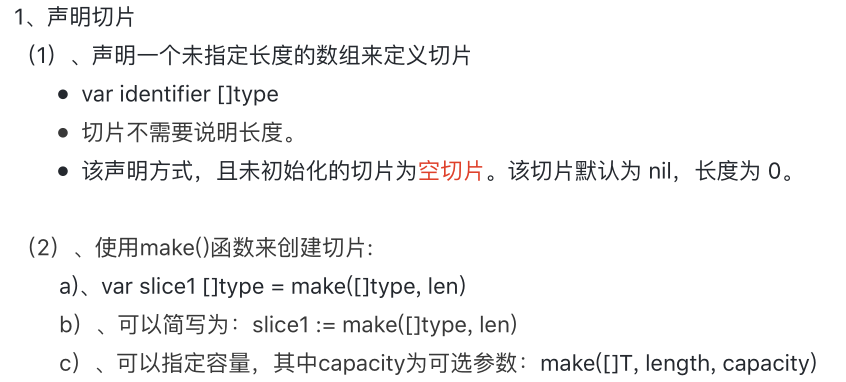What is slicing
Go language slicing is an abstraction of arrays.
- The length of go array cannot be changed, so such a set is not suitable in a specific scene. Go provides a flexible and powerful built-in type slice ("dynamic array");
- Compared with array, the length of slice is not fixed. You can append elements, which may increase the capacity of slice.
- Slices themselves have no data, they are just references to existing arrays.
- Compared with array, slice does not need to set the length, and does not need to set the value in [], so it is relatively free
- Conceptually speaking, slice is like a structure, which contains three elements:
Structure of slice:
- Pointer to the start position specified by slice in the array
- Length, length of SPslice
- The maximum length, that is, the length from the beginning of slice to the last position of the array
II. Use of slices
Slice declaration

s1 := make([]int, 5) s2 := make([]int, 5, 7)
Initialization of slices:

nums := []int{1, 2, 3, 4, 5}
len() and cap() functions
1. The length of slice is the number of elements in slice.
2. The capacity of slice is the number of elements in the underlying array starting from the index of slice creation.
3. Slicing is indexable, and length can be obtained by Len () method. Slicing provides a method of calculating capacity cap (), which can measure the maximum length of slicing. [the result of cap() calculated by array is the same as len()]
4. Slice is actually to get a part of the array, len slice < = cap slice < = len array
package main import "fmt" func main() { s1 := make([]int, 5) s2 := make([]int, 5, 7) printSlice(s1) //length:5,cap=5,slice=[0 0 0 0 0] printSlice(s2) //length:5,cap=7,slice=[0 0 0 0 0] //Create slicing nums := []int{1, 2, 3, 4, 5} printSlice(nums) //To cut a small slice from a slice nums1 := nums[1:4] printSlice(nums1) //length:3,cap=4,slice=[2 3 4] nums2 := nums[:3] printSlice(nums2) //length:3,cap=5,slice=[1 2 3] nums3 := nums[2:] printSlice(nums3) //length:3,cap=3,slice=[3 4 5] } func printSlice(slc []int) { fmt.Printf("length:%d,cap=%d,slice=%v \n", len(slc), cap(slc), slc) }
Common functions of slicing
(V) append() and copy() functions
1. Function append():
- • add new elements to slice
- • you can add one or more elements to slice or a slice.
- The append function will change the contents of the array referenced by slice, thus affecting other slices that reference the same array.
- • when append is used to append elements to slices, if the capacity is not enough (that is, (Cap len) = = 0), Go will create a new memory address to store the elements (which is inefficient).
2. Function copy: * copy slice element
- • copy the elements in the source slice to the target slice, and return the number of copied elements
- The copy method does not establish the connection between the source slice and the target slice. In other words, there is no connection between two slices, and one modification does not affect the other.
package main import "fmt" func main() { //Create slicing nums := []int{1, 2, 3, 4, 5} printSlice("nums", nums) //slice=nums,p=0xc00000c5d0,length:5,cap=5,slice=[1 2 3 4 5] //append Additive element nums = append(nums, 10) printSlice("nums", nums) //slice=nums,p=0xc000014230,length:6,cap=10,slice=[1 2 3 4 5 10] a := []int{6, 7, 8, 9} //Appended array nums = append(nums, a...) printSlice("nums", nums) //slice=nums,p=0xc000014230,length:10,cap=10,slice=[1 2 3 4 5 10 6 7 8 9] //Delete first element nums = nums[1:] printSlice("nums", nums) //slice=nums,p=0xc000014238,length:9,cap=9,slice=[2 3 4 5 10 6 7 8 9] //Delete last element nums = nums[:len(nums)-1] printSlice("nums", nums) //slice=nums,p=0xc000014238,length:8,cap=9,slice=[2 3 4 5 10 6 7 8] //Delete middle element b := int(len(nums) / 2) nums = append(nums[:b], nums[b+1:]...) printSlice("nums", nums) //slice=nums,p=0xc000014238,length:7,cap=9,slice=[2 3 4 5 6 7 8] //Section copy nums2 := make([]int, len(nums), cap(nums)*2) //copy Slice of is not associated copy(nums2, nums) printSlice("nums2", nums2) //slice=nums,p=0xc000014238,length:7,cap=9,slice=[2 3 4 5 6 7 8] } func printSlice(name string, slc []int) { fmt.Printf("slice=%v,p=%p,length:%d,cap=%d,slice=%v \n", name, slc, len(slc), cap(slc), slc) }
3. Create slice with make
package main import "fmt" import "strconv" func main() { str := make([]string, 0, 16) printSlice("str", str) for i := 0; i < 5; i++ { str = append(str, strconv.Itoa(i)) } printSlice("str", str) } func printSlice(name string, slc []string) { fmt.Printf("slice=%v,p=%p,length:%d,cap=%d,slice=%v \n", name, slc, len(slc), cap(slc), slc) }